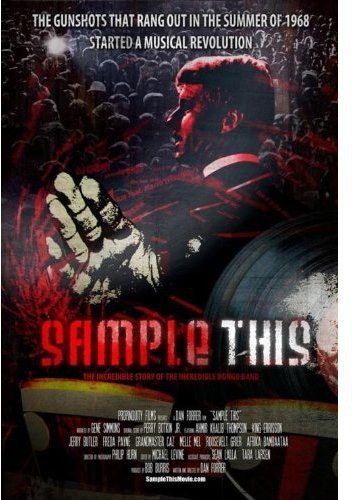
Can a documentary about a song by an obscure band sustain interest for 85 minutes? Surprisingly yes, as proven by the new film Sample This, which chronicles how “Apache” by the Incredible Bongo Band became a cornerstone in the creation of hip hop. While not a hit, the track was rediscovered by early 1970s DJ Kool Herc; by remixing it and playing it at New York street parties, he inspired a generation of emerging artists to sample it for their own tunes.
The story centers on Michael Viner, an unknown music producer who found himself overseeing the music for the 1972 film The Thing with Two Heads. He hired Perry Botkin to score the curious movie; after viewing rough cuts, Botkin decided to accent action sequences with percussion only. To do this, the two recruited some of the best session musicians of the era to cover the 1959 instrumental “Bongo Rock” for the soundtrack. Viner loved the result, and persuaded the players to record an entire album under the moniker “Michael Viner’s Incredible Bongo Band.” MGM Records signed them to their label and released “Bongo Rock ’72” as their first single. While the track made little impact in America, it became a minor hit in Canada. Due to this success, Viner and the band recorded the Incredible Bongo Band’s first album in Canada.
Featuring an international roster, the band recorded tracks including “Apache,” a cover of a 1960 instrumental. Upon completion, many of the players had to return to prior commitments, thus Viner hired replacement players for live shows. The group finally released their debut Bongo Rock in 1973, which featured the title track and “Apache” as well as covers of “In-A-Gadda-Da-Vida” and “Raunchy.” The album ultimately went nowhere, although Viner did commission material for a sequel, Return of the Incredible Bongo Band. Like its predecessor, the LP failed to chart, and the Incredible Bongo Band disbanded. Viner moved on to other projects, eventually making a fortune out of a books on tape company.
Meanwhile, hip hop culture was emerging in the Bronx during 1973. At this time, DJ Kool Herc was hosting street parties, where participants paid a small fee to dance to Herc’s mixes. Considered the Godfather of Hip Hop, Herc constantly sought new beats to excite audiences. Digging through crates of obscure LPs at local record stores, he came across the Incredible Bongo Band’s Bongo Rock. After hearing “Apache,” Herc experimented with expanding the beats, creating extended drum breaks. In addition, he would “scratch” the records to create even more percussion. He spun the reworked tune at parties through the mid-’70s, inspiring new kinds of dancing. By 1977, hip hop had grown substantially, enhanced by the growing popularity of breakdancing. However, rap pioneer Grandmaster Flash brought “Apache”–and mixing–to a new level when he released the 1981 single “The Adventures of Grandmaster Flash on the Wheels of Steel.” A seven-minute mix, the track showcased his considerable mixing skills, blending Blondie’s “Rapture,” Chic’s “Good Times,” and “Apache” among numerous other songs.
Since then, “Apache” has become one of music’s most sampled tracks, its breaks appearing in tracks by Jay-Z, Missy Elliot, Will Smith, and Amy Winehouse. Viner passed away in 2009 (his close friend Gene Simmons narrates the documentary), and some original Incredible Bongo Band members have also passed on. For Sample This, the remaining members regrouped in a Canadian studio to record new music. Despite the members’ age, their impressive playing skills have remained intact.
Sample This features interviews from such hip hop luminaries as Melle Mel, Afrika Bambaataa, and DJ Kool Herc; The Roots’ Questlove adds his views, as do select Bongo Band members. Freda Payne (“Band of Gold”) chimes in, as she once seriously dated Viner and lends a very personal perspective. Some of the claims are dubious; for example, the film claims that The Beatles used to play “Apache” in concert, and that Ringo Starr may have participated in some Incredible Bongo Band recording sessions. Still, Sample This is a fascinating look at how a little-known track spurred the creation of a new genre.